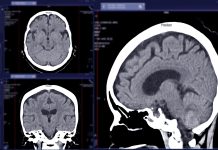Researchers at the University of Nottingham have used a lightweight, wearable OPM‑MEG brain scanner to uncover distinct brain‐function changes in people with Multiple Sclerosis, a non‑invasive advance that could improve diagnosis and tracking of disease progression
A study led by the University of Nottingham has, for the first time, applied wearable magnetoencephalography (OPM‑MEG) technology to people with multiple sclerosis (MS). Unlike MRI scans, which map brain structure, this wearable system tracks brain function in real-time during natural movements and everyday postures, revealing altered neural communication and slower motor-area responses in MS patients. The findings not only open up promising new avenues for predicting disease progression and tailoring treatment but also bring hope for improved diagnosis and disease monitoring.
The results have been published in Neuroimage: Clinical.
Revoluntionising MS with OPM-MEG scanner
Multiple sclerosis (MS) is a chronic autoimmune disease that affects the brain and spinal cord. It occurs when the immune system mistakenly damages myelin, a protective fatty substance that insulates nerve fibres. This damage leads to a range of neurological symptoms, including numbness, vision problems, balance issues, and fatigue.
Scientists used a newly developed OPM-MEG scanner, which features a lightweight helmet and a backpack-mounted control unit that uniquely allows for the measurement of electrical brain signals while people are resting, standing, walking, or performing movement-based tasks. The technology measures the brain in real-time by measuring the magnetic fields generated by electrical currents flowing through assemblies of neurons.
New hope for patients with MS
In experiments involving participants with and without MS, the researchers demonstrated how neural circuits in the brain’s visual system are affected by the demyelination of neurons in MS. Additionally, they showed that the movement area of the brain responded more slowly in individuals with the condition.
The team also examined brain activity when participants were standing, as many MS patients have balance issues. They found that the brain rhythms that characterise healthy cortical function (typically known as “brain waves”) changed more when people with MS were standing, compared to people without the condition.
Pietro Navarra was diagnosed with Primary Progressive Multiple Sclerosis (PPMS) two years ago and took part in the research. He said: “PPMS has an impact on my short-term memory, and routinely (daily) makes me feel fatigued, and thus, having an afternoon nap has become a necessity. I wanted to participate in the research, as there are currently very few treatments for PPMS. If I could support any developments, it could help me and others. Additionally, if possible, I would like to actively work on improving rather than being a passive observer in my decline (I hope this doesn’t happen!).
I hope that this research will identify details of MS progression that can be targeted, maybe treating progression in different parts of the brain differently. I also hope it can support early diagnosis so that progression can be stopped before it has any impact.”
Ben Sanders and Christopher Gilmartin from the University of Nottingham led the study. Physics PhD student Ben Sanders commented: “OPM-MEG can record how the brain is working in real-time, in a range of postures, and during natural movements. Our paper shows that this unique capability can bring new insights to MS.”
Christopher Gilmartin from the School of Medicine and Health Sciences added, “We are now building on this with further research to track brain activity in people with MS over time. We hope that in the long term, OPM-MEG may help us predict those individuals whose MS symptoms will get worse, and those who will have more stable disease. Such a prognosis would be a significant benefit when treating MS patients.”








